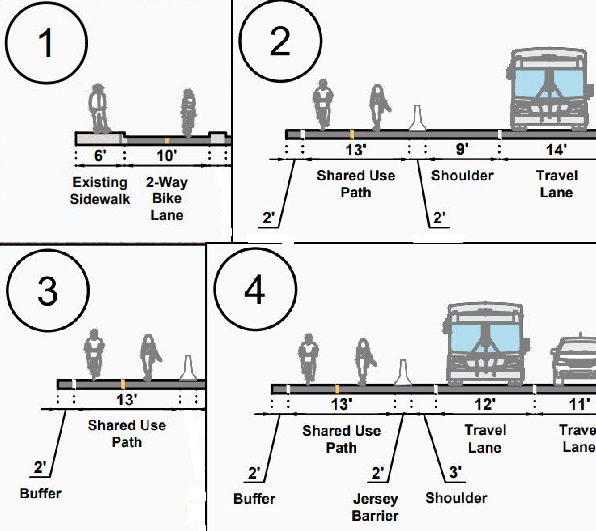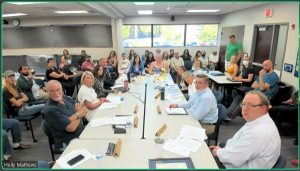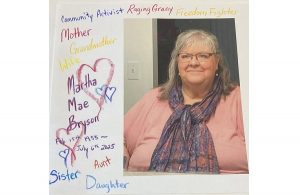Modified plan for East 30th goes to commissioners
8 min read
An advisory committee approves a shared-use path separated from East 30th. But will it save lives, or is it still dangerous? During the public comment session on September 28th, Allan Hancock.
[00:00:12] Allen Hancock: Hi. My name is Allen Hancock and I’m a regular bicyclist to the Mount Pisgah area, and I take many recreational rides which take me over 30th Avenue. And I’m grateful for all the hard work and in general I’m very supportive of this plan of having the Jersey barriers and the separation.
[00:00:31] But there are a couple things that were discussed at some of the public meetings that I don’t think have been fully addressed.,
[00:00:38] John Q: The proposed design funnels all active transportation into a 13-foot-wide strip, on a long steep downhill run with no escape. If a child or a dog steps across the line, bicycles won’t be able to stop. Allen Hancock points out they have nowhere to go.
[00:00:53] Allen Hancock: On the downhill portion of 30th Avenue, bicyclists, especially e -bicyclists, could be going at a very high speed and could cause a hazard for pedestrians who might not hear them.
[00:01:05] My second concern is the intersection where the separated route for bicycles and pedestrian meets the turnoff for Lane Community College. That’s a very awkward arrangement, which bicycles would have to slow to a halt to be able to continue on.
[00:01:24] And those people who are heading downhill will have to lose all of their momentum, which may not seem like a big thing. But it’s already quite an effort to get up and over the hill by bicycle. And to have to come to a halt to be able to cross there just means one more barrier.
[00:01:41] It makes it a disincentive for people to ride a bicycle and I don’t think that that’s the overall goal. So I’m not sure what kind of changes might need to be made to ameliorate that. But I think that they need to be looked at.
[00:01:54] Otherwise, I think that this is a really great design concept. And again, thank you for your work.
[00:02:00] Alex: I really appreciate the work that has been done on this, and I think the plan is excellent with the caveats that some of the other speakers have brought up.
[00:02:08] But there’s still a long way to go before there is a safe walking and bicycle route to Mount Pisgah. And not all of that is the county’s jurisdiction, but I hope that work will continue to be done to make a safe and welcoming human-powered path all the way to Mount Pisgah eventually.
[00:02:27] John Q: Here’s the design team giving an overview of the project.
[00:02:32] Sasha Varsavian: Tonight we’re going to provide a brief overview of the process to date to identify the design concept being proposed. And we will hold a public hearing and then hear from the Transportation Advisory Committee (TrAC) about their recommendation to the Board of County Commissioners.
[00:02:49] The community comments were so robust that Becky (Taylor, project manager) summarized the comments in 89 pages. So to boil it down much much more quickly for you: There was the support for change. Over 67% of people voted that there needed to be some sort of change on 30th Avenue, and 33% said do nothing.
[00:03:10] So there is not conclusive support for the project; however, the majority of people who have participated and provided comment do support changing the makeup of 30th Avenue.
[00:03:22] Some key concerns and issues raised by the public: The importance of protection for people walking and biking; fear of vehicle lane reduction for multiple reasons; congestion concerns in the case of an emergency; being able to evacuate safely; the safety at intersections, and how many crashes have occurred at intersections; unknown land development in the future and what that means for traffic on 30th Avenue.
[00:03:50] And then we also heard a lot of comments, which we made sure to share with our agency partners, specifically Eugene Oregon Department of Transportation, about desires for their facilities as well.
[00:04:00] So to summarize, the staff recommendation is the design concept that was presented to you in much more detail at the July 27th TrAC (Transportation Advisory Committee) meeting.
[00:04:10] The design addresses priority safety issues. It defers major changes to the future urbanization process, so that can really define what the need is in the future.
[00:04:21] It balances interests of what we heard from the community, for example, not reducing lanes because of concerns there. And it acknowledges that not all concerns are addressed and that subsequent design work is needed for more detailed engineering.
[00:04:41] Sue Wolling: Hi, I’m Sue Wolling. I live in Eugene. I strongly urge you to approve the draft design for 30th Avenue so we can move ahead toward trying to fund and build improvements to make this road safer for everybody. A number of years ago when I was taking Spanish classes, I rode my bike to LCC four days a week for two years.
[00:04:59] I guess the good thing about it was that compared to the bike ride to get me to class, learning Spanish was a piece of cake. Between the high-speed traffic, the tricky highway-style ramps on and off the road and the hill, this is not an easy or comfortable bike ride, and there are not a lot of people who do it, though there are a surprising number of LCC staff who commute by bike.
[00:05:20] But that makes it all the more amazing that despite the relatively small number of people walking or biking on 30th, there have been more people killed or seriously injured while walking or riding a bike than on any other road in Lane County. In addition, there are a large number of crashes involving cars. It’s just not a safe road for anybody.
[00:05:38] The proposed design would use existing right-of-way to make significant safety improvements. A protected path for walking and bicycling would make a huge difference and would pave the way, so to speak, for more people to use their new e-bikes or scooters to travel over the hill to LCC, to the new park land in the Black Oak Basin, or even out to Mount Pisgah.
[00:05:58] Meanwhile, a roundabout at Eldon Shafer would improve both flow and safety in the highest crash location of the corridor. And motorists making left turns onto Forest or Bloomberg could wait in a center turn lane for a safe time to turn instead of worrying that an inattentive motorist is going to plow into them from behind.
[00:06:18] As the draft proposal points out, the sections of the facility controlled by the city of Eugene and by ODOT also need improvements for the corridor really to feel safe and connected. But these improvements to the Lane County section of 30th Avenue are an important place to start.
[00:06:31] Please approve the proposed designs so we can move ahead toward making this important corridor safer for everybody.
[00:06:38] Jennifer Hayward: I work at Lane Community College and I’ve worked there for 23 years and for almost all of the 23 years that I’ve been working there, I’ve been advocating for safe bike and pedestrian routes from Eugene to the college. So I’m really excited that we’re discussing this today.
[00:06:54] Some of the reasons why I care about it is because obviously providing New safe routes for students and employees to get there by bike and by walking. It’s going to help low-income students and employees who don’t have access to a personal vehicle.
[00:07:08] And, for a lot of people the bus just doesn’t work, and it costs money too. And it’ll support people’s fitness goals. And it also supports LCC’s and the community’s climate goals. So those are my reasons, and I’m done.
[00:07:23] JJ MacLean: Thank you. Yeah, so I actually work over I-5 and in my time working over here, going across 30th from my home in Southeast Eugene, you can definitely see the a lot of the danger posed by that arterial for anyone who’s not in a car. And I think the proposed changes to 30th on the county side definitely is going to have a lot of traffic calming that I think will be beneficial for folks in vehicles.
[00:07:44] And that protected shared space for bikes and pedestrians is going to be critical for equitable access for anybody getting across to LCC, to recreation, to work in that general area.
[00:07:56] And specifically with the kind of recent popularity of e-bikes, I think that also puts some of the issues with 30th, just how steep it is, that is less of an issue now that an e-bike is more an affordable option for someone, thus making it even more equitable.
[00:08:11] And if anything, we’re going to see more and more traffic. We’re not going to see less in that corridor. Doing this earlier really I think sets up the county and Eugene and Springfield for that growth that will inevitably come.
[00:08:24] Dennis Hebert: I just have a couple of things to comment on about dealing with future design phases to explore passive detection, to activate the crossings and the sensors.— a flashing light to make cars aware that a bicycle was approaching there. I think that’s something that should be installed right away because that’s kind of a bad spot for bicycles merging and cars trying to get into the lane and everything.
[00:08:48] So I would just like to stress that we need to get those signs, those like electronic signs and lights and stuff for the bicycle safety going over dealing with Spring Boulevard.
[00:09:00] John Q: He asked the county to check up on the city to ensure that the Spring Boulevard overpass won’t tumble during an earthquake. That would block an evacuation route used by thousands.
[00:09:11] Dennis Hebert: This is Dennis here, I don’t know how Lane County can do it, but if you can impress upon the city to give some kind of assessment as far as being earthquake proof and safety and everything else for that overpass, it would be greatly appreciated.
[00:09:27] I think y’all have done fantastic work on this whole project and I’m with Southeast Neighbors Board and y’all have come speak to us and we’re really impressed with the presentation and the professionalism of your staff. So I’d just like to say thank you very much and we appreciate all the time that you have given for a public input. That’s it. Thank you.
[00:09:49] Sasha Varsavian: Thank you, Dennis. That is similar to the conflict points that Mr. Hancock also mentioned, and I believe those are design details that we can incorporate in and investigate further as we identify funding for preliminary engineering.
[00:10:04] John Q: The plan next goes to county commissioners.



